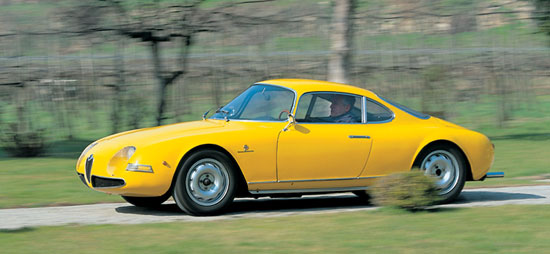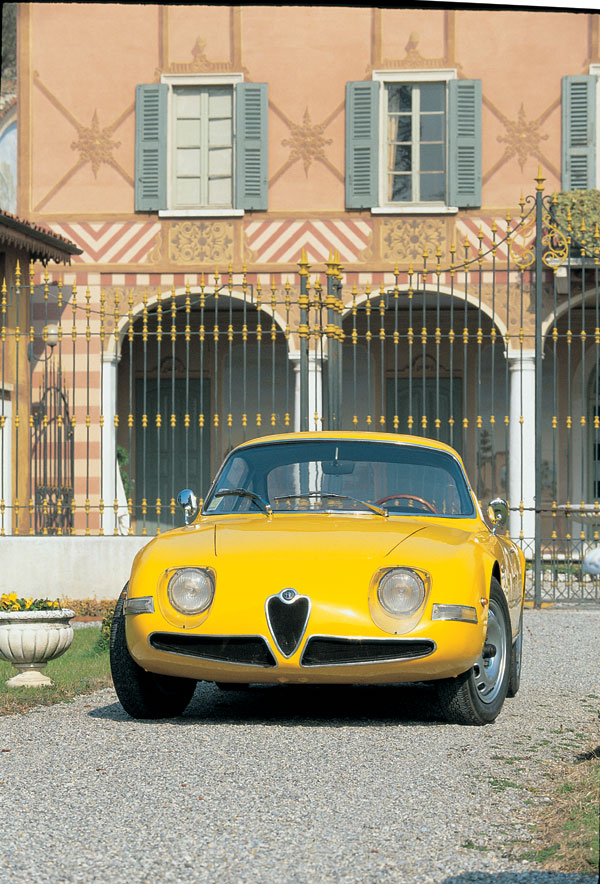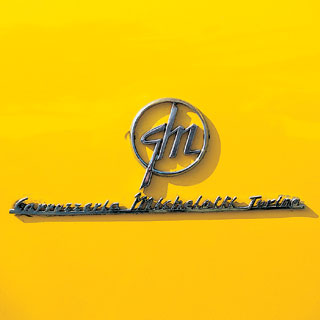
The following is an edited extract from Auto Italia magazine, July 2004. For access to the full feature, plus articles on the Lamborghini Gallardo, Ferrari 250GT Lusso, Maserati Spyder Cambiocorsa and much more, see www.auto-italia.co.uk
Michelotti (1921 – 1980) designed cars – lots of cars. Have a guess how many: 50? 100? Nope. Michelotti penned 1,200 cars including 190 Ferraris. In the 1954 Turin Show, more than 40 cars were by Michelotti. He has designed cars for Ferrari, Maserati, BMW and countless others. In the UK he is perhaps best known for his Triumphs – the Herald, TR4, 5, 6, Spitfire, GT6 and 1300, 1500, Toledo, Dolomite, 2000 and Stag. His last design to see production was the Reliant Scimitar SS1.
 Cars don’t come much rarer than this Alfa Romeo Michelotti Conrero. Tipped off by Abarth guru Tony Berni, we travelled to Brescia to find this original yellow one-off, supplied to us by Fiat main dealer Pierangelo Pasini, of Franzoni Auto. We drove to nearby Villa Badia Piccola for our photo location. Michelotti made the camera lie, as the proportions of this coupe are that of a big car. Pictures make it look Alfa 2600-sized but it is actually the size of the 1956 Giulietta Sprint Veloce (1,300cc) underneath. Nicknamed ‘Goccia’ (pronounced gotcha) it is Italian for ‘drop’, as in teardrop. It was in 1961 that the car acquired its Michelotti body and Conrero motor. Definitely not a Motor Show poseur, this car has period competition history. Driven by Munaron and De Leonibus, it ran at Monza in 1961 in the Coppa Ascari 6-hours where it vied for the lead against the works Alfa SZ of Sanesi before a transmission problem dropped the ‘drop’ to seventh. Monza races apart, other outings include a class win in the 1961 Aosta-Pila Hillclimb.
Cars don’t come much rarer than this Alfa Romeo Michelotti Conrero. Tipped off by Abarth guru Tony Berni, we travelled to Brescia to find this original yellow one-off, supplied to us by Fiat main dealer Pierangelo Pasini, of Franzoni Auto. We drove to nearby Villa Badia Piccola for our photo location. Michelotti made the camera lie, as the proportions of this coupe are that of a big car. Pictures make it look Alfa 2600-sized but it is actually the size of the 1956 Giulietta Sprint Veloce (1,300cc) underneath. Nicknamed ‘Goccia’ (pronounced gotcha) it is Italian for ‘drop’, as in teardrop. It was in 1961 that the car acquired its Michelotti body and Conrero motor. Definitely not a Motor Show poseur, this car has period competition history. Driven by Munaron and De Leonibus, it ran at Monza in 1961 in the Coppa Ascari 6-hours where it vied for the lead against the works Alfa SZ of Sanesi before a transmission problem dropped the ‘drop’ to seventh. Monza races apart, other outings include a class win in the 1961 Aosta-Pila Hillclimb.
Its two-seater brief means that there is plenty of room for ‘design’. The rear haunches are predominant and the large diameter (15-inch) wheels give a modern body-to-wheel ratio. The voluptuous bumperless shape is in aluminium with Carrozzeria Michelotti Torino badges on the front wings. Alfa Romeo heritage has been retained with the distinctive front end although the headlamps under glass do impart a studious, bespectacled appearance. A slight tint and they would be designer shades. The wheels and finned drum brakes are so Alfa. I recognise the windscreen as that beautiful quarter-elliptical shape of the Alfa Romeo Giulia/Giulietta SS. The rest of the windows are in plexiglass with the overall weight of our yellow machine down at just 750kg.
Getting in and out is difficult and reminiscent of the Alfa SS. Both seats are slim with the one on the driver’s side being a low-back bucket type. No belts are fitted. The big steering wheel extends down too close to the seat making it very difficult to get in. With such light steering (due to the lightness of the whole car) the Michelotti Alfa would benefit greatly from a smaller, period steering wheel. Not necessarily a design fault on the part of Michelotti who was stuck with the layout. It is a 750/101 Series Giulietta/Giulia Coupe fault but I’m amazed how drivers can live with such an easily solved discomfort.
 |
 |
 |
Italy has only been a united country since 1871. Before that, the separate states fought or competed with each other – a legacy which still exists through a strong sense of regionalism. So when Michelotti, a Piemontese from Turin, wanted an engine builder, he went to Conrero – also Torinese. The engine work was carried out by Riccardo Michi of Conrero who remembers the excellent job they made of the engine – high power with high torque. The Lombardians (from the Alfa Romeo Milano factory) would have felt peeved that the Piemontese had been messing about with ‘their’ car. Conrero/Michi reworked the 1,300cc twin cam to produce 130bhp. Achieving 100bhp per litre in those days was hard enough for a race engine. That it had to be capable of road use is even more impressive. Weighing just 750kg, this means a power-to-weight ratio of 173bhp per tonne. Enough for a 0-60 time of 9 seconds and a top speed of 135mph. The 4-speed gearbox (with a 1:1 top gear ratio) has since been replaced by a 5-speed box, making use of the taller fifth gear.
 The driving experience is typical Giulietta: lively and communicative, but more so. Body roll – although less than that of a Giulietta – is still high by modern standards but for the period it was brilliant. The body roll means it can cope with poor surfaces while maintaining traction. The clutch is light, and quick downchanges demand spirited toe-heeling if the synchros are to survive. Below 5,500rpm the Goccia delivers an even spread of power but nothing special. The real power band is between 6,000 and 7,700rpm where the teardrop flies. That power band also complements its low drag coefficient.
The driving experience is typical Giulietta: lively and communicative, but more so. Body roll – although less than that of a Giulietta – is still high by modern standards but for the period it was brilliant. The body roll means it can cope with poor surfaces while maintaining traction. The clutch is light, and quick downchanges demand spirited toe-heeling if the synchros are to survive. Below 5,500rpm the Goccia delivers an even spread of power but nothing special. The real power band is between 6,000 and 7,700rpm where the teardrop flies. That power band also complements its low drag coefficient.
The open inlet trumpets and straight-through exhaust compete with mechanical thrash to overwhelm the car’s rudimentary sound insulation. Busy and purposeful and a guarantee of exclusivity to its new owner – whoever that will be. Yes, this beautiful teardrop of racing and design history is for sale and I have no idea of its value. Entries to the best historic racing events are hard to come by – but cars like the stunning one-off Goccia are in demand.
|
Words by Roberto Giordanelli. Pictures courtesy of Phil Ward and Auto Italia magazine.
See www.auto-italia.co.uk or call 01858 438817 for back issues and subscriptions. |




